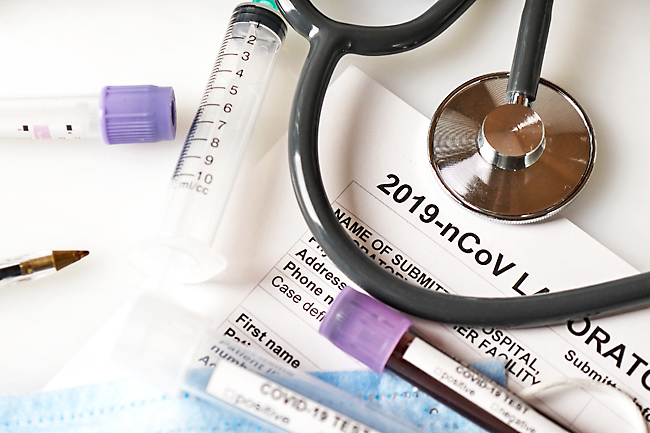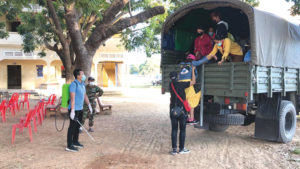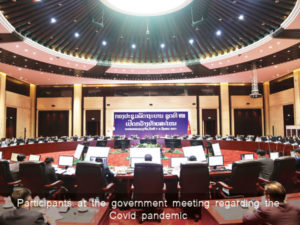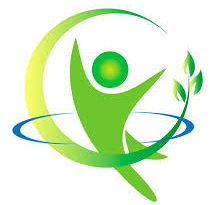ASEAN COVID-19 PANDEMIC UPDATES: PART 1: BRUNEI TO MALAYSIA- Here is the ASEAN status as of Friday, 7am, January 8, 2021
COVID-19 infection crosses more than 86.7 million globally as deaths cross more than 1.87 million.
.
The coronavirus COVID-19 is affecting 218 countries and territories around the world and 2 international conveyances.
.
Cases globally:
Deaths:
Recovered:
.


.
Ads by: Memento Maxima Digital Marketing
@[email protected]
SPACE RESERVE FOR ADVERTISEMENT
Coronavirus Cases globally :Deaths: Recovered:
.
Here is the ASEAN status as of Friday, 7am, January 8, 2021


.
Ads by: Memento Maxima Digital Marketing
@[email protected]
SPACE RESERVE FOR ADVERTISEMENT
.
>BRUNEI
.
.
Brunei records one new imported COVID-19 case
James Kon
Brunei Darussalam recorded one new imported COVID-19 case yesterday, bringing the current number of active cases in the country to 21.
Minister of Health Dato Seri Setia Dr Haji Mohd Isham bin Haji Jaafar said this during a press conference yesterday.
“Case 173 is a man aged 38 who arrived in Brunei on the SQ148 flight on December 25, 2020, via Singapore from Indonesia. He showed no signs of infection and is currently being monitored and treated at the National Isolation Centre (NIC). Contact tracing for this case is still being conducted,” the minister said.
Permanent Secretary at the Ministry of Health (MoH) Haji Abdul Manap bin Othman was also present.
With the latest imported case, the total number of confirmed COVID-19 cases in the country is 173.
All of the active cases are currently receiving treatment at the NIC in the Tutong District.
One case is in the Intensive Care Unit while the rest are in stable condition.

With the detection of the new case, 32 import cases have been confirmed. Since the last local case reported on May 6, 2020, Brunei has recorded 246 days without local COVID-19 transmissions.
A total of 700 individuals are undergoing mandatory self-isolation at government monitoring centres after arriving in the country from abroad. At present, 10,765 individuals have completed their mandatory self-isolation at the monitoring centres.
In the past 24 hours, 382 SARS-CoV-2 virus samples were tested, bringing the total number of laboratory tests conducted since January 2020 to 84,830.
The minister also reminded members of the public to practise social responsibilities by maintaining personal hygiene and observing proper cough and sneeze etiquette.
The public are recommended to wear face masks in crowded public places, and to avoid public places, gatherings or events if feeling unwell.
The minister also warned that as per the provisions under the Infectious Diseases Act (Chapter 204), the public is required to comply with all regulations and instructions issued in response to the COVID-19 pandemic.
Updates can be obtained by visiting www.moh.gov.bn, or by contacting the Health Advice Line at 148, or through the BruHealth app.

.
>CAMBODIA
Another migrant worker cluster tested positive for C-19, incresing to 21 and overall tally now 386
 Migrant workers arrive at a quarantine centre in Battambang province. Battambang Provincial Health Department
Migrant workers arrive at a quarantine centre in Battambang province. Battambang Provincial Health DepartmentCambodia’s migrant workers COVID-19 cluster cases has expanded again today with the finding of another infection, bringing the cluster case to 21 and the Kingdom’s total cases to 386.
.
COVID-19: Cambodia relaxes restrictions, Singapore, Indonesia promotes vaccination plans

In contrast to some regional countries, Cambodia has begun easing restrictions imposed for the past six weeks that followed a COVID-19 outbreak last November.
On January 4, students wearing masks lined up for temperature checks and hand washing before being allowed to enter the Sovannaphumi primary school in the capital Phnom Penh.
While private schools have started reopening this week, students at public schools are due to return next Monday.
Cambodia has also reopened the Tuol Sleng Genocide Museum, a famous tourist destination in Phnom Penh.
In November, Cambodia put in place a range of restrictions after an outbreak of community transmission linked with a 56-year-old woman who had travelled to the country’s two biggest cities since November 20.
In neighbouring Thailand, authorities warned on January 4 that the country could face a strict lockdown as infection numbers climbed, spurring it to declare 28 provinces high-risk zones.
The same day, Singapore said it will consider relaxing travel restrictions for people who have been vaccinated against COVID-19, including for those planning to visit the city-state for the World Economic Forum (WEF) in May.
The country has largely banned leisure travel because of the pandemic, and has limited business and official travel agreements with certain nations.
Last week, it became one of the first countries in Asia to embark on a national inoculation programme.
Singaporean Health Minister Gan Kim Yong said more vaccines are expected to arrive in Singapore in the next few months, including those by US firm Moderna and China’s Sinovac.
He said in the parliament that there will be enough COVID-19 vaccines for Singaporeans and long-term residents of Singapore by the third quarter of 2021 if all goes according to plan.
The country received its first shipments of the Pfizer-BioNTech COVID-19 vaccine in December.
In Indonesia, a mass vaccination programme is set to start next week as about 700,000 doses of vaccines have already been widely distributed.
The nation has secured more than 329 million doses of COVID-19 vaccines, most notably from Pfizer and its partner BioNTech, and AstraZeneca. However, those to be used in the first phase are CoronaVac, the vaccine produced by China’s Sinovac.
Budi Gunadi Sadikin, Indonesia’s health minister, has said that the country needs to inoculate about 181 million people, or roughly 67 percent of its population. About 1.3 million health workers would be first in line for the shots, followed by public servants. VNA

>INDONESIA
.JANUARY 07, 2021

>LAOS
.
Latest Update January 8, 2021)
.Govt mulls plans to minimise impacts of pandemic

Economic issues, particularly ways to strengthen the economy while minimising the impacts of the Covid-19 pandemic, are among the most important issues being discussed at a government meeting which began in Vientiane on Thursday.
The meeting, chaired by Prime Minister Thongloun Sisoulith, is being attended by government cabinet members, the mayor of Vientiane and provincial governors from January 7-8.
.
Meeting participants reviewed the implementation of the socio-economic development plan for 2016-2020 and discussed plans for the next five years.
Other important items discussed at the meeting on Thursday included progress made in improving investment climate indicators, improvements in approving investment and granting business licences, commercial production, and a report on a study of ways to convert State assets into capital.
On Friday, cabinet members, the Vientiane mayor and provincial governors will discuss the outcomes of the government’s measures in response to Covid-19 and how the pandemic has affected the economy. They will also debate a report on Laos’ preparations to graduate from the UN’s list of least developed countries.
Last year, Laos suffered severe economic hardship when the Covid-19 pandemic hit tourism, investment and other service businesses, which are the country’s main sources of revenue.
The pandemic caused rising unemployment and the government has pledged to address this issue.
The government has done a good job in keeping Covid-19 in check even as more cases are reported in the region.
The government is committed to carrying out economic reforms and moving towards sustainable development, ensuring an increase in Gross Domestic Product (GDP).
According to a report in the Lao Economic Daily, the economy grew at an average annual rate of 5.8 percent over the past five years, with annual average income per capita rising to US$2,664.
The government projects that the economy will grow by 4-5 percent annually in the years 2021-2015, with an annual inflation of not more than 6 percent.
One of the government’s most important policies is to improve mechanisms and measures to address economic difficulties and ensure quality growth and stability of the macro-economy. The government also plans to improve the structure of the economy, with a focus on SMEs and economic development along the Laos-China economic corridor and East-West and North-South economic corridors.
Laos has huge potential to generate more income from tourism due to its natural beauty and historical and cultural places of interest. The government has vowed to remove more barriers and improve the business climate in a bid to attract more investment from within Laos and from foreign countries to further boost economic growth.
By Somsack Pongkhao
(Latest Update January 8, 2021)

>MALAYSIA<
.
Covid-19: 2,433 new cases, nine deaths recorded today – Health DG (Updated)

KUALA LUMPUR: A total of 2,433 new Covid-19 cases were recorded in the country today with nine more casualties, while five new clusters were detected, according to Health director-general Tan Sri Dr Noor Hisham Abdullah.
With 1,277 more recoveries, the cumulative number of those who had been cured of Covid-19 in Malaysia is 108,109, or 79.5 per cent of the total number of cases.
Dr Noor Hisham said 135,992 positive cases had been detected in the country to date, while 27,332 cases were still active.
“Of the total number of new cases reported today, seven are imported from abroad, while 2,426 are local transmissions.
“Of the local transmissions, 1,784 cases involve Malaysian citizens, and 642 cases are of non-citizens,“ he said in a statement today.
He said Selangor reported the highest number of new daily cases with 730, followed by Sabah (403) and Johor (321).
Dr Noor Hisham said the death toll today involved six men including two non-citizens, as well as three Malaysian women – aged between 37 and 94 – from Selangor, Kuala Lumpur and Sabah.
ADVERTISEMENT
There are also 171 Covid-19 cases being treated at the Intensive Care Unit (ICU) with 76 requiring respiratory assistance.
Meanwhile, Dr Noor Hisham said there were five new clusters detected today, namely the Cyber Construction Site Cluster, Texmile Cluster and Jalan Sibuga Cluster; as well as two cross-state clusters, namely the Alor Durian Cluster and Wakaf Lanas Cluster.
The Cyber Construction Site Cluster which involves the districts of Sepang, Petaling, Klang, and Hulu Langat in Selangor recorded 67 positive cases; The Texmile Cluster in Gombak, Selangor (19 cases), while the Jalan Sibuga Cluster in Sandakan, Sabah, recorded nine cases.
Apart from that, the Alor Durian Cluster in Tumpat and Kota Bahru, Kelantan recorded 17 cases and the Wakaf Lanas Cluster in Pasir Puteh, Kelantan with 11 cases.
Dr Noor Hisham said the clusters that had ended today were Bandar Impian Cluster, Indah Mas Cluster, Kubota Cluster, Batu Tiga Cluster, Red House Cluster, Sri Jujur Cluster, and PTS Sibuga Cluster.
“This brings the total number of active clusters being monitored to 254, and out of them, 65 clusters reported an increase in the number of cases today. — Bernama


.
SIGN UP TO RECEIVE OUR EMAIL
.
The most important news of the day about the ASEAN Countries and the world in one email: aseanews.net
.











